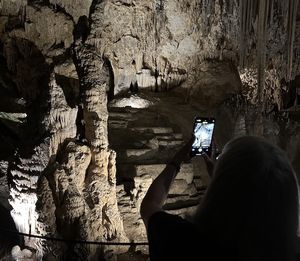Spain’s Costa del Sol: More than just beaches
There comes a time in any extended trip when you run out of clean clothes. Yes, I do pack the kind of clothing that is easy to wash out, rinse and hang up to dry in the bathroom of whatever lodging we book.
Then again, nothing beats having freshly laundered clothing, smelling nice, all folded and ready to wear whatever the new day brings. So, after rising early our second day at the Ona Marinas de Nerja Spa Resort in Nerja, Spain, and spending a few minutes watching other guests slowly take their assigned spots under the resort’s neatly rowed and colorful beach umbrellas, we headed to breakfast.
Did I say that the resort felt like being on a cruise ship? Not that I necessarily mean that as criticism. Access to water, evening entertainment and a full breakfast buffet all fit the cruise-ship template, which appeals to a lot of people, especially those with children. Funny thing, though, hardly any of the people I was watching, children or adults, were braving the sea. It was sunny and the air felt warm, but the Mediterranean must have been too chilly for even the UK visitors – which, of course, says something.
In any event, we didn’t get in the water either, mainly because we were on a mission. Referring to Rick Steves again, we discovered that Nerja had a laundromat that offered same-day service. And so, dirty clothing in hand, we drove into town. Even with GPS, we had a bit of trouble finding it. When we did, however, we were disappointed: The place handled only commercial laundry needs. Seems even Rick Steves sometimes can be mistaken.
As luck would have it, though, just a few blocks away we found a coin-operated laundromat. Moreover, that’s where we met an American woman expatriate whose ancestors came from the area. And as our clothes got washed and then dried, we got acquainted: She was a divorcee from California, she had moved to Nerja a few years before, she was still learning Spanish, and she loved her new life. It was just the kind of encounter that makes travel so illuminating – to experience the kind of alternative existence that most of us just fantasize about.
Clean clothes safely stored away, we then sought out one of Nerja’s major attractions: its cave. Discovered in 1959, by a group of locals reportedly out looking for bats, La Cueva de Nerja sits just a short drive east of the city itself and is both easy to find and access (ample parking is available).
Admission to the cave is 14 euros for adults, 6 for children 6 to 12, with those younger than 6 free. Though the cave boasts three different galleries, only one is open to the public. But that in itself is worth the price. A 45-minute walk along stone pathways and wooden stairs brings visitors up close and personal with any number of majestic rock formations – stalagmites, stalactites, etc. – though I should point out that elderly people or anyone with a disability would have a hard time getting around.
When we emerged from the cave, and after perusing the attendant museum for souvenirs, we decided to explore the town of Frigiliana that sits in the hills above Nerja. Mary Pat and I have spent time in a number of Italian hill towns, from Orvieto to San Gimignano, Cortona to Montepulciano, so we were anxious to see what a Spanish equivalent might offer.
Our first opportunity came when we managed to snare the last couple of seats on a kind of motorized train, which took us up and around the town’s steeply sloped streets. The trip, which lasted less than a half hour gave us a feel for the town, a glimpse of the nearby castle ruins and a glorious view of the distant sea some six kilometers away. The only drawback: Our guide spoke no English (though English-speaking tours can be booked). No matter. Some sites speak for themselves.
Oh, and we had lunch, too, at one of the street-side restaurants situated just off the main plaza, Restaurante Bar Virtudes. And for convenience, courteous and competent help, not to mention deliciousness, it ended up being one of the most memorable meals of our whole trip. The salad I ordered was particularly tasty.
Later, when we returned to our hotel, we took a leisurely walk along the beach. At one point, we saw a couple of locals emerging from the water, both wearing – not surprisingly – wetsuits. They then were confronted by a couple of police officers who’d parked their car right next to the clearly marked “no swimming” sign. We walked on as the four worked out their differences with an impressive series of hand gestures.
Then we found ourselves again on our terrace, reminiscing about our day while watching hotel employees on the beach below gradually put away the umbrellas and lawn chairs. And so ended our last night on the Costa del Sol.
Next up: On to Sevilla.

